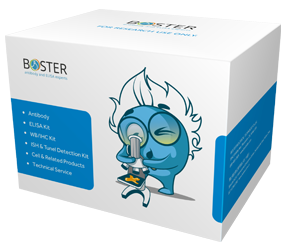Product Info Summary
| SKU: | A10567-1 |
|---|---|
| Size: | 100 μg/vial |
| Reactive Species: | Human, Mouse, Rat |
| Host: | Rabbit |
| Application: | WB |
Customers Who Bought This Also Bought
Product info
Product Name
Anti-GPR161 Antibody Picoband®
SKU/Catalog Number
A10567-1
Size
100 μg/vial
Form
Lyophilized
Description
Boster Bio Anti-GPR161 Antibody Picoband® catalog # A10567-1. Tested in WB applications. This antibody reacts with Human, Mouse, Rat. The brand Picoband indicates this is a premium antibody that guarantees superior quality, high affinity, and strong signals with minimal background in Western blot applications. Only our best-performing antibodies are designated as Picoband, ensuring unmatched performance.
Storage & Handling
At -20°C for one year from date of receipt. After reconstitution, at 4°C for one month. It can also be aliquotted and stored frozen at -20°C for six months. Avoid repeated freezing and thawing.
Cite This Product
Anti-GPR161 Antibody Picoband® (Boster Biological Technology, Pleasanton CA, USA, Catalog # A10567-1)
Host
Rabbit
Contents
Each vial contains 4 mg Trehalose, 0.9 mg NaCl, 0.2 mg Na2HPO4.
Clonality
Polyclonal
Isotype
Rabbit IgG
Immunogen
A synthetic peptide corresponding to a sequence at the C-terminus of human GPR161, identical to the related mouse sequences.
*Blocking peptide can be purchased. Costs vary based on immunogen length. Contact us for pricing.
Cross-reactivity
No cross-reactivity with other proteins.
Reactive Species
A10567-1 is reactive to GPR161 in Human, Mouse, Rat
Reconstitution
Adding 0.2 ml of distilled water will yield a concentration of 500 μg/ml.
Observed Molecular Weight
60 kDa
Calculated molecular weight
10201 MW
Background of GPR161
G-protein coupled receptor 161 is a protein that in humans is encoded by the GPR161 gene. The protein encoded by this gene is an orphan G protein-coupled receptor whose ligand is unknown. This gene is overexpressed in triple-negative breast cancer, and disruption of this gene slows the proliferation of basal breast cancer cells. Therefore, this gene is a potential drug target for triple-negative breast cancer.
Antibody Validation
Boster validates all antibodies on WB, IHC, ICC, Immunofluorescence, and ELISA with known positive control and negative samples to ensure specificity and high affinity, including thorough antibody incubations.
Application & Images
Applications
A10567-1 is guaranteed for WB Boster Guarantee
Assay Dilutions Recommendation
The recommendations below provide a starting point for assay optimization. The actual working concentration varies and should be decided by the user.
Western blot, 0.25-0.5 μg/ml, Human, Mouse, Rat
Positive Control
WB: human SH-SY5Y whole cell, huamn SiHa whole cell, rat brain tissue, rat spleen tissue, mouse brain tissue
Validation Images & Assay Conditions

Click image to see more details
Figure 1. Western blot analysis of GPR161 using anti-GPR161 antibody (A10567-1).
Electrophoresis was performed on a 5-20% SDS-PAGE gel at 70V (Stacking gel) / 90V (Resolving gel) for 2-3 hours. The sample well of each lane was loaded with 30 ug of sample under reducing conditions.
Lane 1: human SH-SY5Y whole cell lysates,
Lane 2: huamn SiHa whole cell lysates,
Lane 3: rat brain tissue lysates,
Lane 4: rat spleen tissue lysates,
Lane 5: mouse brain tissue lysates.
After electrophoresis, proteins were transferred to a nitrocellulose membrane at 150 mA for 50-90 minutes. Blocked the membrane with 5% non-fat milk/TBS for 1.5 hour at RT. The membrane was incubated with rabbit anti-GPR161 antigen affinity purified polyclonal antibody (Catalog # A10567-1) at 0.5 μg/mL overnight at 4°C, then washed with TBS-0.1%Tween 3 times with 5 minutes each and probed with a goat anti-rabbit IgG-HRP secondary antibody at a dilution of 1:5000 for 1.5 hour at RT. The signal is developed using an Enhanced Chemiluminescent detection (ECL) kit (Catalog # EK1002) with Tanon 5200 system. A specific band was detected for GPR161 at approximately 60 kDa. The expected band size for GPR161 is at 60 kDa.
Protein Target Info & Infographic
Gene/Protein Information For GPR161 (Source: Uniprot.org, NCBI)
Gene Name
GPR161
Full Name
G-protein coupled receptor 161
Weight
10201 MW
Superfamily
G-protein coupled receptor 1 family
Alternative Names
Neutrophil defensin 1;Defensin, alpha 1;HNP-1;HP-1;HP1;HP 1-56;Neutrophil defensin 2;HNP-2;HP-2;HP2;DEFA1;DEF1, DEFA2, MRS;DEFA1B; GPR161 RE2 G protein-coupled receptor 161 G-protein coupled receptor 161|G-protein coupled receptor RE2
*If product is indicated to react with multiple species, protein info is based on the gene entry specified above in "Species".For more info on GPR161, check out the GPR161 Infographic

We have 30,000+ of these available, one for each gene! Check them out.
In this infographic, you will see the following information for GPR161: database IDs, superfamily, protein function, synonyms, molecular weight, chromosomal locations, tissues of expression, subcellular locations, post-translational modifications, and related diseases, research areas & pathways. If you want to see more information included, or would like to contribute to it and be acknowledged, please contact [email protected].
Specific Publications For Anti-GPR161 Antibody Picoband® (A10567-1)
Hello CJ!
No publications found for A10567-1
*Do you have publications using this product? Share with us and receive a reward. Ask us for more details.
Recommended Resources
Here are featured tools and databases that you might find useful.
- Boster's Pathways Library
- Protein Databases
- Bioscience Research Protocol Resources
- Data Processing & Analysis Software
- Photo Editing Software
- Scientific Literature Resources
- Research Paper Management Tools
- Molecular Biology Software
- Primer Design Tools
- Bioinformatics Tools
- Phylogenetic Tree Analysis
Customer Reviews
Have you used Anti-GPR161 Antibody Picoband®?
Submit a review and receive an Amazon gift card.
- $30 for a review with an image
0 Reviews For Anti-GPR161 Antibody Picoband®
Customer Q&As
Have a question?
Find answers in Q&As, reviews.
Can't find your answer?
Submit your question





